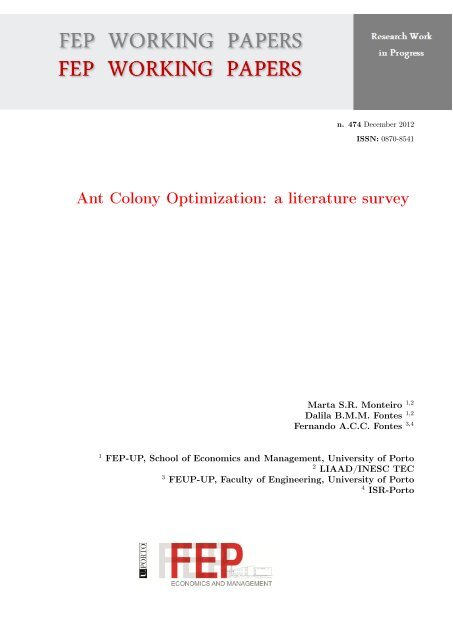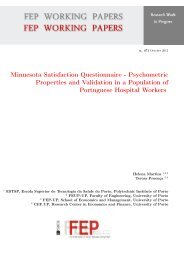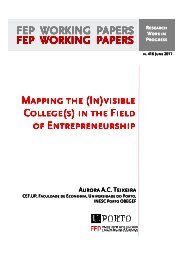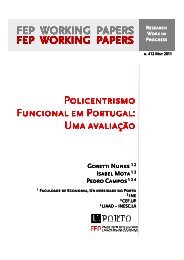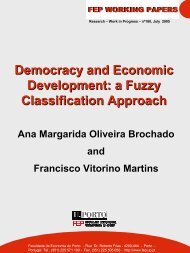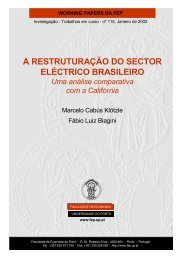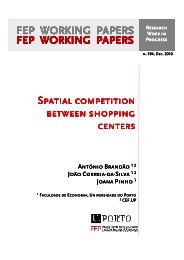Ant Colony Optimization: a literature survey - FEP - Working Papers
Ant Colony Optimization: a literature survey - FEP - Working Papers
Ant Colony Optimization: a literature survey - FEP - Working Papers
Create successful ePaper yourself
Turn your PDF publications into a flip-book with our unique Google optimized e-Paper software.
n. 474 December 2012ISSN: 0870-8541<strong>Ant</strong> <strong>Colony</strong> <strong>Optimization</strong>: a <strong>literature</strong> <strong>survey</strong>Marta S.R. Monteiro 1,2Dalila B.M.M. Fontes 1,2Fernando A.C.C. Fontes 3,41 <strong>FEP</strong>-UP, School of Economics and Management, University of Porto2 LIAAD/INESC TEC3 FEUP-UP, Faculty of Engineering, University of Porto4 ISR-Porto
(Crawford and Castro, 2006), and even with Genetic Algorithms as is the case of (Altiparmakand Karaoglan, 2007). This allowed ant algorithms to achieve even better results in problemstoo complex to be solved by a single heuristic method.In the following section we will explore, in detail, the first ant algorithm, that was called the <strong>Ant</strong>System. Afterwards, we review some of the large number of interesting works that have beendeveloped ever since. We focus our attention mostly in works that have introduced modificationsand extensions to the so-called building blocks of ACO algorithms. This is made with thepurpose of showing alternative methods, that worked well with specific optimization problems,so that the reader who is developing an ACO algorithm can easily perceive its utility and howto adapt it for the problem at hand.2 <strong>Ant</strong> <strong>Colony</strong> Principles<strong>Ant</strong> <strong>Colony</strong> <strong>Optimization</strong> principles are based on the natural behaviour of ants. In their dailylife, one of the tasks ants have to perform is to search for food, in the vicinity of their nest.While walking in such a quest, the ants deposit a chemical substance called pheromone in theground. This is done with two objectives. On the one hand, it allows ants to find their way backto the nest, such as Hansel and Gretel in the fairytale. And on the other hand, it allows otherants to know the way they have taken, so that the others can follow them. The curiosity is that,because hundreds or even thousands of ants have this behaviour, if one could see the pheromonelaid in the ground as a kind of light, the ground would be a large network with some of the arcsbrighter than the others. Within the paths created by those arcs would surely be the shortest pathbetween the nest and the food source. This behaviour can be seen as a kind of communicationbetween the ants. If the path has a large concentration of pheromone, this is probably due to itsshorter length that allowed ants to travel faster, resulting in a larger number of travels throughthe path therefore with much more ants depositing pheromone on it. Furthermore, over timethe pheromone evaporates and thus its concentration reduces. The more time it takes for the antto travel from the nest to the food source and back to the nest, the more time the pheromoneshave to evaporate. This system is thus based both on the positive feedback, i.e. depositing ofpheromone attracts other ants to use the same path which will increase the pheromone quantity,and on negative feedback, i.e. dissipating of the pheromone through evaporation leads tolower levels of pheromone thus discouraging other ants. Deneubourg et al (1990) and Goss et al(1989) performed some experiences with real ants and they where able to show that foragingants can find the shortest path between their nest and some food source, by the use of a chemicalsubstance called pheromone, that they deposit while walking. After these experiments theauthors proposed a stochastic model to describe what they had observed. This was the first stepleading to an optimization algorithm based on the foraging behaviour of ants. Some years later,Dorigo et al (1996) developed the first foraging ants algorithm which was called <strong>Ant</strong> System and3
that was firstly proposed to solve the travelling salesman problem.2.1 <strong>Ant</strong> SystemThe objective of the travelling salesman problem is to find the shortest route between a set ofcities, starting and finishing in the same city, going through all cities without visiting each citymore than once. This problem is very easily adapted to the idea of the <strong>Ant</strong> System due to theirsimilarity in concepts: find the shortest path between two points in a graph.An AS algorithm considers a single ant colony with m artificial ants cooperating with eachother. Before the algorithm starts to run each arc linking two different cities is given a certainquantity of pheromone τ 0 . This is usually a very small value just enough to ensure that theprobability of each arc to be chosen is different from zero. Also, the ants are created.The algorithm has two main phases, the construction of the tour/solution and the pheromoneupdate. Other important decisions have to be made before the ants can start finding a solution,such as defining the structure (representation) of the solution, or the initial pheromone quantityto be given to each arc. These questions will be discussed further ahead.At each iteration each ant is randomly placed in a city, from the set of n cities. That city will bethe starting point of the tour that is to be constructed by the ant. A solution to the TSP can berepresented by a set of n consecutive cities. Therefore, at each step of the construction the anthas to choose, with a given probability, the next city to travel to.This choice is made by using a transition rule, the short expression for random proportionaltransition rule, that uses a combination of attractiveness of the city, which is given by theheuristic information η ij of the problem, and of the fitness of the move, i.e. past usage, whichis given by the pheromone quantity τ ij . The transition rule quantifies the probability of ant k,positioned at city i, travelling to city j and it is given by:P kij (t) =[τ ij(t)] α · [η ij ] β∑[τ il (t)] α · [η il ] , (1)βl∈J k iwhere η ij , the heuristic information or visibility of arc (i, j), is the inverse of the distancebetween city i and city j, i.e.J k iη ij = 1d ij, (2)is the set of cities not yet visited by ant k while at city i, and α and β are parameters weightingthe relative importance of the pheromone and of the heuristic information, respectively.Therefore, the closest cities, that is, the ones that the ant can see from where it is standing, will4
have a higher visibility value, whereas the others will have a lower one.The values α and β are two tunable parameters that weight the pheromone information and theheuristic information on the transition rule.After building the solutions the pheromone values in the arcs are updated. The update is donein two phases. Just before the ants can deposit pheromone in the arcs of their solution, thealgorithm applies an evaporation rate ρ, with ρ ∈]0, 1], to the pheromone present at each arc,see equation (3).τ ij (t) = (1 − ρ) · τ ij (t). (3)This operation simulates the natural process of evaporation preventing the algorithm from convergingtoo quickly (all ants constructing the same tour) and getting trapped into a local optimum.The value of the evaporation rate indicates the relative importance of the pheromonevalues from one iteration to the following one. If ρ takes a value near 1, then the pheromonetrail will not have a lasting effect, potentiating the exploration of the solutions space, whereas asmall value will increase the importance of the pheromone, potentiating the exploitation of thesearch space near the current solution.The length S k of each tour is then calculated and the ants will be allowed to deposit pheromonein every arc of their tour. The pheromone quantity to be deposited in each arc is proportionalto the quality of the solution of each ant and to the number of ants to incorporate that arc in itssolution, as can be seen in equations (4) and (5).⎧⎨∆τij(t) k =⎩∆τ ij (t) =m∑k=1∆τij k (t), (4)Qif (i, j) belongs to the solution of ant k,S k (t)0 otherwise,(5)where Q is a positive proportionality parameter and S k (t) is the length of the tour constructed byant k at iteration t. For small problem instances, this update leads to a reduction of the searchspace thus converging to one where the optimal solution components will have the highestvalues in the matrix. However, for large instance problems it is known that stagnation is likelyto happen, driving the solution to a suboptimal solution rather than to an optimal one. This iswhy pheromone evaporation is so important.The previous steps are performed until some stopping criterion is reached, which can be a fixednumber of iterations, as was the case, but it can also be the setting of a bound on running timeor even the number of solutions evaluated.5
The best values for the parameters used in ant algorithms depend both on problem characteristicsand on the strategy chosen for searching the solution space. Therefore, before setting valuesfor the parameter, decisions on the search strategy have to be made. Then, the algorithm mustbe run several times in order to establish the values of the parameters which tend to performbetter.3 <strong>Ant</strong> <strong>Colony</strong> <strong>Optimization</strong>Meanwhile, some improvements were inserted into the AS such as the introduction of elitistants into the colony (Dorigo et al, 1996), the ranking of ants (Bullnheimer et al, 1997), andthe bounding of the allowed accumulated pheromone in each path (Stützle and Hoos, 1997).Nevertheless, the most important development is the description of the <strong>Ant</strong> <strong>Colony</strong> <strong>Optimization</strong>Metaheuristic by Dorigo and Di Caro (1999) and Dorigo et al (1999). The ACO, whichis described in Algorithm 1, is made of general guidelines for the development of algorithmsbased on foraging ants to solve combinatorial optimization problems.Algorithm 1 Pseudo-code for <strong>Ant</strong> <strong>Colony</strong> <strong>Optimization</strong>.1: Initialize parameters2: Initialize pheromone trails3: Create ants4: while Stopping criteria is not reached do5: Let all ants construct their solution6: Update pheromone trails7: Allow Daemon Actions8: end whileThe main difference from the basic structure of the AS algorithm is the introduction of a Daemon.The daemon can perform problem specific operations or centralized operations, which useglobal knowledge of the solutions, thus having a very active and important role in the algorithm.Note that in contrast to the AS no global knowledge is used since each ant deposits pheromonein its solution despite what the other solutions are like. This is a task that has no equivalencein the nature. The daemon can, for example, control the feasibility of each solution or givean extra pheromone quantity to the best solution found from the beginning of the algorithm orto the best solution in the current iteration. These last operations were already mentioned inprevious algorithms but never attributing its responsibility to a main entity in the colony.Another important feature, frequently used by authors on ant based algorithms is the introductionof Local Search procedures following the construction of the solutions. This is an optionalfeature that has been proved to be very important in the exploitation of the search space near togood solutions, leading almost always to better performances of the ACO.6
3.1 The building blocks of an ACOACO algorithms have a set of characterising features that can be considered as their step stones.These features must always be specified, preferably, when describing the algorithm:• method chosen to construct the solution,• heuristic information,• pheromone updating rule,• transition rule and probability function,• parameters values, and• termination condition.It becomes obvious that the combination of the different techniques, that can be developed foreach of them, result in a large diversity of ant colony algorithms, each of which more adequateto a certain class of problems. Within the vast <strong>literature</strong> on the subject, different proposes canbe identified to either improve earlier results or simply to solve a new type of problems. In thissection, and for each of these building blocks, we review some of the extremely large numberof techniques previously proposed, since it is impossible to track all the work that has beendone ever since the early stages of ant algorithms. Nonetheless, the reader is always referred tothe works that will be discussed in this section, for further details, as well as to the referencestherein.3.1.1 Constructing a solutionThe construction of a solution, along with its representation, is one major issue of an ant algorithm,as it is with any other heuristic method, since it will influence the rest of the procedures tobe defined. Thus, it plays a crucial role on the success of the algorithm. Besides, it is commonknowledge that it has a great effect on the running time of the ACO algorithm (Neumann andWitt, 2010). Therefore, if the construction is badly chosen, the probability of a bad performanceis high.Regarding the solution construction, a critical decision is whether to allow or not that unfeasiblesolutions are constructed. This decision alone, can have several outcomes, such as:• allowing the construction of unfeasible solutions and then creating an extra procedure tofix them. This may involve too much of running time effort just to fix the solution;7
• allowing the construction of unfeasible solutions and then discarding or penalizing unfeasiblesolutions. In this case, it may happen that the number of usable solutions is toosmall (or even nonexistent), and thus the algorithm converges quickly to a suboptimal solution.Even if this is not the case, if there are several constraints being violated then it istoo hard to use the penalties since they are of different nature and thus may have oppositebehaviours;• if only feasible solutions are allowed, then the construction procedure may be too complexleading to large running times.The construction of a solution is influenced by many aspects, such as the problem being solvedand the constraints to be considered, the representation chosen for the problem, the investigatorpreferences, and so on.Alaya et al (2004) solve a Multidimensional Knapsack problem where a decision on a subsetof objects, satisfying a few resource constraints, has to be made in order to maximize the totalprofit. The solution for this problem only requires the choice of a subset of objects to be introducedin the knapsack, with no order specified, and can then be represented as a string of objectidentifiers. Each ant starts the construction of their solution by randomly choosing an objectto be put in the knapsack. Then, objects are added to the solution, by using a transition ruleas defined in equation (1), as long as they do not violate any resource constraint. This way afeasible solution is always obtained.Rappos and Hadjiconstantinou (2004), in order to design two-edge connected flow networks,use two types of ant colonies sharing information about their pheromone levels. This problemis about configuring a network in order to satisfy demand nodes, provided that an extra arc isconsidered to keep the network flowing in the case that one of the arcs in the network fails.The solution for this problem is constructed in two phases, each of which solved by a differenttype of ants. One ant colony is inhabitated by flow ants and the other colony by reliability ants.The number of flow ants is the same as the number of demand nodes and, although they allstart constructing their solution from the source node, each ant is assigned to reach just onespecific demand node. When all flow ants have constructed their partial solutions, reachingtheir demand node destination, the network is created. The next step involves the reliabilityants whose objective is to decide upon the extra arc, called reliability arc, to be added to thesolution. For every flow ant a reliability ant is created and associated with each arc visited bythe flow ant. Therefore, for each flow ant there is a set of reliability ants, as many as arcs inthe solution of the flow ant. The objective of a reliability ant is to find an alternative path fromthe root node to the same destination node of the flow ant as long as it does not use a particulararc, from the ones used in the solution of the flow ant. This ACO algorithm provides a singlefeasible solution at each iteration, which is only entirely defined when all partial solutions ofthe flow ants have been assembled together, and the extra arc found by the reliability ants is8
identified.Baykasoglu et al (2006) solve a dynamic facility layout problem, where each ant has to decide,for each period t, the location of the n departments considered. The authors use a stringwith size t × n to represent the final solution, where the first n consecutive values identify thedepartment locations for the first period, the second n consecutive values give the locationsfor the second period, and so on. Therefore, to construct a solution, all an ant has to do is tochoose t × n elements of the type department location, accordingly to the pheromone levels,and provided that, within a time period, no department location is repeated, thus guaranteeingthe construction of a feasible solution.Partitioning and covering problems are solved with ACO algorithms by Crawford and Castro(2006). In this case, given a set of columns and rows, the objective is to choose a subset ofcolumns covering all rows while minimizing cover costs. The solution is represented by asubset of columns. This implies a different approach, from the ones we have been mentioningbefore, because the solution components are represented by nodes and not by arcs, a fact thatsimplifies the calculations. The construction is straightforward. Each ant starts with an emptyset of columns. Then, the ant adds columns one at the time, based on pheromone values, untilall rows are covered. Solutions constructed in this way, can be unfeasible in the partitioningcase because a row may be covered by more than one column. That is why post processingprocedures, that will try to eliminate redundant columns, are added afterwards in order to turnunfeasible solutions into feasible ones.In a transportation problem with N supply nodes and M demand nodes, it is known that asolution has, at most, N + M − 1 arcs. This observation allows Altiparmak and Karaoglan(2006) to decide on allowing each ant in their algorithm to be able to choose N + M − 1 arcsto construct a feasible solution. Each ant starts by randomly choosing an arc from the set ofavailable arcs A, and proceeds the construction by adding, one at the time, the remaining arcsby using pheromone information. The arcs in the set of allowed arcs to be chosen to enterthe solution is defined by the demand and supply nodes that have not exceeded already theirdemand and supply, respectively. In this case the sense of path is not applied since arcs arechosen arbitrarily as long as they satisfy demand and supply constraints.The Single Source Capacitated Facility Location Problem deals with the location of a set offacilities, with a limited capacity on the supply, and the allocation of a single facility to eachcustomer so as to satisfy customer demands and minimize total costs. Chen and Ting (2008)propose an algorithm to solve it which integrates an <strong>Ant</strong> <strong>Colony</strong> System with two types of ants,location ants and assignment ants. Therefore, there are two different solution representationsand constructions. Location ants select the facilities to be opened, and their solutions are notuniform, in the sense that each ant can open a different number of facilities, according to:9
⌊ ∑ ⌋if a =d i∑j (s + U[0, r], (6)j/m)where f a is the number of facilities to be opened by ant a, d i is the demand of customer i, s jis the supply on node j, m is the number of available locations for the facilities, and r is apre-specified integer constant with a value between the first term of the sum in equation (6) andm. After selecting the facilities to be opened, assignment ants assign each customer to one andonly one facility but they do not acknowledge, at least in this phase, whether the solution isfeasible or not, from the supply capacity point of view. The unfeasible solutions are dealt withby using penalties, in the local search phase.3.1.2 Visibility InformationThe heuristic information, also known as visibility, is an extra information available to the antalgorithm which is usually referred to as a kind of local information. Originally used as theinverse of the length of the arc between two cities in the TSP, it has suffered several mutationsthroughout the hundreds of approaches that have been developed since then.Lessing et al (2004) studied the influence of the heuristic information, also called the visibilityvalue, in the performance of ant algorithms when solving Set Covering Problems (SCPs). Twotypes of heuristic information are studied, static heuristic information, where the values arecalculated only once, at the beginning of the algorithm, and dynamic heuristic information, inwhich case the values are calculated at each construction step of each ant, as in the case of theant-density algorithm. The different heuristic information values used are based on the ColumnCosts,η j = 1 ; (7)c jthe (normalized) Lagrangean Costs C j ,η j = 1 C j; (8)the Cover Costs,η j = card j(S)c j, (9)where card j (S) is the number of rows covered by a column j;(normalized) Lagrangean Cover Costs,η j = card j(S)C j; (10)10
Marchiori and Steenbeck Cover Costs,η j =1(c j /cv(j, S) , (11)where cv(j, S) is the sum, for all rows covered by column j but not covered by any other columnin S \ {j}, of the minimum cover costs;Marchiori and Steenbeck Lagrangean Cover Costs with Normalized Costs,η j =1(C j /cv(j, S) ; (12)and finally lower bounds, where the heuristic information for column j is the inverse of the costof the lower bound obtained by tentatively adding column j.Each of these heuristic information types was tested with four different ant algorithms, and theresults obtained suggest that different types of heuristic information should be used for differenttypes of ant algorithms.Reimann and Laumanns (2006) use savings values as the heuristic information instead of theusual inverse of the arc cost,η ij = S ij , (13)in an ACO algorithm to solve Capacitated Minimum Spanning Tree problems. The savingsS ij = c i0 + c 0j − c ij are related to the cost difference obtained by merging the subtrees of nodei and j, previously linked directly to the source node 0. In this case, the larger the savingsassociated to an arc the higher probability of that arc being selected.A Capacitated Fixed-Charge Location problem aims at deciding on the supply facilities thatmust be opened such that they can satisfy all the customers demand at the lowest possiblecost. Venables and Moscardini (2006) developed an ACO based algorithm that defines anduses the information of a matrix called the total opportunity matrix T ij . This matrix uses thesum of the differences between the cost of each arc (i, j), that is c ij , and both c i ∗ j the lowersupplying cost from facility i and C ij ∗ the lower supplying cost to customer j, such that T ij =(c ij −c ij ∗)+(c ij −c i ∗ j). At the end, the visibility is set to be the facility visibility, and is definedas the sum on the customers index of the total opportunity cost,n∑η i = T ij . (14)j=1The lower the T ij the higher the visibility and probability of an arc to be chosen.In the work of Altiparmak and Karaoglan (2007) the heuristic information is based on the concavenature of the arcs costs in the Transportation Problem to be solved. In this case, the11
heuristic information takes into account not only the cost of the arc c ij but also the flow of thatarc x ij , that is the unit transportation costη ij =1(c ij / √ x ij ) . (15)Pour and Nosraty (2006) have solved the NP-hard plant/facility location problem with an ACOalgorithm. In this problem, there is a set of existing facilities p i and a set of locations wherenew facilities x j are to be located and the objective is to locate these new facilities, such thatthe sum of the costs between the facilities is minimized, and each location is assigned a singlefacility. In this algorithm, the heuristic information used by the authors is defined as the inverseof the product of distances d i and costs f i between existing facility i and all new facilities x j ,taking the form ofη ij = 1f i · d j. (16)This way, nearest and lower cost facilities have a better heuristic value.The Minimum Weight Vertex Cover problem is solved by Shyu et al (2004) with an ACOalgorithm where the heuristic information is defined for pairs of the type (node, ant). In it, theheuristic information is defined as the local preference of ant k to choose node j to enter thesolution, and it translates into the ratio between the number of arcs linked to node j but not yetcovered by ant k and the weight of node j. Being thus defined, this heuristic information is notstatic because its value changes with each step of the construction of the solution, and also fromsolution to solution, since ants may construct different solutions.Crawford and Castro (2006) calculate the value of the heuristic information in a dynamic fashion,to solve Partitioning and Covering problems. At each step of the construction of the solution,the algorithm computes the heuristic information as the per unit cost of covering anadditional row, as given bellowη j = e jc j, (17)where e j is the number of additional rows that are covered by node j when it is added to thepartial solution already constructed.In the Cell Assignment Problem a set of cells must be linked to a set of switches such that eachcell is associated to exactly one switch, however switches may be linked to several cells. Shyuet al (2006) define two heuristic information matrices, instead of the usual single one, to beused in an ACO algorithm developed to solve the Cell Assignment Problem. These matrices areassociated with the choice of to which switch to move to when located at a certain cell, and viceversa.On the former, the decision uses a heuristic information function based on the inverse ofthe partial costs. This heuristic information is dynamic since whenever an arc (c i , s j ) linking12
a cell c i and a switch s j is included in the partial solution, the heuristic value for that arc willbe updated with the inverse of the partial solution cost constructed to the moment. This updateis performed at each step of the construction procedure. Therefore, the higher the partial costthe lower the value of the heuristic information η ci ,s j. Whenever an ant is located at a certainswitch it must choose to which cell to move to. In order to do so, the heuristic information usedis the call volume associated with each cell, thus η ci is defined for cells rather than for arcs.Therefore, the larger the cell volume the higher the value of the heuristic, thus favouring cellswith high call volumes to be handled first.3.1.3 Pheromone BoundsAt some point on the run of an ACO algorithm, the values of the pheromones in the componentsof the solution, let us say arcs, may be extremely small, almost prohibiting the choice of thosearcs, or extremely large which will lead to the construction of the same solution, over andover again. To prevent that from happening one might set upper and a lower bounds on thepheromones. The first work to introduce this mechanism was (Stützle and Hoos, 1997), and theauthors define the following pheromone bounds:τ max = 1ρF ∗ , (18)where the pheromone upper bound τ max depends not only on the evaporation rate ρ but also onthe total cost of the best solution found so far F ∗ ;τ min = τ max(1 − p dec )( n − 1)p , (19)2 decwhere the pheromone lower bound τ min depends on the value of τ max , on the the number n ofthe components of the solution, and on the probability of constructing the best solution p dec ,which is a value to be set.Therefore, whenever a new global best solution is found, τ min must also be updated.Venables and Moscardini (2006) and Altiparmak and Karaoglan (2007) both define the upperbound τ max , as in equation (18). The minimum pheromone value allowed is given by a fractionof the maximum pheromone value allowed,τ min = τ max /a, (20)where a is a parameter value given by the size of the problem both in the work of Venables andMoscardini (2006) and in the work of Altiparmak and Karaoglan (2007). It is easy to see thatτ min and τ max are not static values changing whenever a new best solution is found.13
has to be paid for using that arc. The other one, T f (ij), is called the flow trail and is related tothe cost of the flow passing through the arc. Flow ants, which can detected and reinforce bothpheromone types, are created, as well as reliability ants, that can only detect and reinforce arcpheromone. In each iteration a single solution is produced by the flow ants, and then the solutionis made reliable by adding an extra arc by the reliability ants. Both flow trails and reliabilitytrails are updated, at the end of the corresponding construction phase, by initially performing areduction on the pheromone of all arcs. Then, each reliability ant adds:∆T e (ij) = 1b ij(27)to each arc on its solution, regarding the arc pheromone trail, where b ij is the fixed cost to beincurred by using arc (i, j). Each flow ant adds the following quantities to the arc and flowpheromone trails, respectively, on the arcs of its solution, provided that fixed-costs are onlypaid once∆T e (ij) = 1b ijand ∆T f (ij) = 1c ij d j, (28)where c ij is the cost per unit flow and d j is the demand of node j. The reason why reliabilityants to not deposit pheromone on flow trails is straightforward, the extra arc that they add to thesolution does not carry any flow.In a work by Alaya et al (2004), where multidimensional knapsack problems are solved, thepheromone update is done in such a way that the quantity deposited in each component of thesolution includes information about the difference between the objective function value of thebest solution of the iteration F (S it ) and of the global best solution F (S ∗ ),∆τ ij =11 + F (S ∗ ) − F (S it ) . (29)Therefore, the closer the solution is to the global best solution, the higher the quantity ofpheromone deposited.Two pheromone updating rules are proposed in (Shyu et al, 2004), a global and a local one.On the one hand, at the end of each iteration, and after evaporation is applied, the pheromonepresent on the nodes of the incumbent solution S ∗ are reinforced with a quantity inverselyproportional to the total weight of the nodes in the solution.∆τ i =1∑j∈S ∗ w j. (30)On the other hand, the local pheromone updating rule is applied each time the ant adds a nodeinto its solution and is given by16
τ i = (1 − ϕ)τ i + ϕτ 0 (31)where τ 0 is the initial pheromone laid in every node and ϕ is the evaporation rate applied locally.This latter rule has the objective of preventing the ants of always choosing the most significantnode. Eswaramurthy and Tamilarasi (2009) have also used a similar global and local updatingrule but considering arcs instead of nodes. It should be noticed that while Shyu et al (2004)solve the Minimum Weight Vertex Cover problem, Eswaramurthy and Tamilarasi (2009) solvethe Job Shop Scheduling problem.Solimanpur et al (2005), have also considered depositing more pheromone in the componentsof the solutions closer to the global best solution. In this case, they allow not only the best antin the iteration to deposit pheromone but also all other ants. The amount of pheromone to bedeposited by ant k is given by∆τ k ij = λ · F (S∗ )F (S k ) , (32)where F (S k ) is the solution of ant k, and λ is a scaling factor that must be chosen appropriatelysuch that a quick convergence to a local optima may be avoided. This method clearly encouragessearch along the vicinities of the global best solution in the hope that a better one can be foundnearby.According to the value defined in equation (22), Blum and Blesa (2005) define a pheromoneupdating rule rewarding three solutions: the best solution in the current iteration Sk ib , the bestglobal solution to the moment S gbk, and the restart-best solution Srb k , that is, the best solutionfound at the restart of the algorithm. The reinforcement is then not based on the fitness of thesolution, that is, the corresponding value of the objective function, but rather on the value of aconvergence factor cf, see equation (22), which is computed at every iteration. Each of thesethree solutions is attributed a different weight k ib , k gb , and k rb , defined in the same manner asabove, such that their sum equals 1. The schedule the authors have applied is dependent oncf in such a way as to increase the value of k rb and decrease the value attributed to k ib withthe increase of cf, if cf < 0.99. The value of the evaporation rate parameter is also dynamic,decreasing with the increase of cf. When a global convergence has been reached, that is, whencf ≥ 0.99 then the only solution being updated is S gbksince a reset of the algorithm is to bemade, and this is the only solution to be maintained. The pheromone values are updated, aswell, initially by evaporating a percentage of the pheromone present in each arc, and then byadding the following pheromone quantity in each arc,ξ a = k ib δ(Sk ib , a) + k rb δ(Sk rb , a) + k gb δ(S gb , a), (33)k17
where δ(S k , a) = 1 if arc a belong to the solution tree S k , and 0 otherwise.Following the work of Bin et al (2009), Yang et al (2007) use an ant-weight pheromone updatingstrategy based on the ant-density algorithm, in the Improved ACO used to solve the VehicleRouting Problem. The idea behind it is to incorporate both local and global information aboutsolutions. Therefore, every ant, representing a single route, deposits pheromone in its solutioncomponents, following∆τ k ij =QK × L × Dk − d ijm k × D k , (34)where Q is the usual proportionality constant parameter, L is the sum of the lengths of all toursin the solution, K is the total number of routes in the solution, D k is the length of tour k, d ij isthe distance between customer i and customer j, and m k is the number of customers visited inroute k. Note that, a solution is only entirely defined when all routes constructed are assembled.QThe first component , the global pheromone increment, depends on the total length of theK × Lsolution and on the number of tours, and it represents a compromise between the total cost andthe number of vehicles used. The second component Dk − d ij, the local pheromone increment,m k × Dk uses the contribution of arc (i, j) to the kth tour, which increases as d ij decreases.3.1.5 Transition Rule and Probability FunctionThis may be considered the characteristic that has less suffered from the evolution of ant algorithms.Its initial structure, as given in equation (1), is almost always used in the works of theresearchers in the area. Nonetheless, different methods have been introduced mainly associatedto the high complexity of the problem to be solved.The probability distribution used by Bouhafs et al (2006) to calculate the probability of visitingcustomer j when in customer i, in a Capacitated Location-Routing problem, also incorporatesthe savings value γ ij , for visiting customer j from customer i:P kij (t) =[τ ij (t)] α · [η ij ] β · [γ ij ] λ∑j∈J k i[τ ij (t)] α · [η β ij ] · [γ ij] λ (35)where Jik is the set of costumers not yet visited by ant k in its solution and that, by beingchosen, do not violate any constraint. The savings value is computed once at the beginning ofthe algorithm as followsγ ij = d i0 + d i0 − g · d ij + f · |d i0 − d 0j |, (36)where g and f are parameters, d ij is the distance between nodes i and j, and 0 is the startingnode.Afshar (2005) proposes a new transition rule for ant colony optimization algorithms, that is18
given by:P kij(t) =∑ατ ij (t) + βη ij[ατ ij (t) + βη ij ] . (37)j∈J k iThe strategy is defined to prevent a domination of the pheromone trails in the ants decision, byincorporating an additive form instead of the usual multiplicative form. This way, the authorexpects both pheromone and heuristic information to have an active role in the decision. Thisnew transition rule comes with a modification of the heuristic value, which is a simple scalingprocedure given by:η s ij =η ijmax(η ij ) , (38)making every value to be between zero and one regardless of problem size, a difficulty whichwas already mentioned before.A probability function based on the one developed by Maniezzo (1999) for the Quadratic Assignmentproblem is used within an algorithm developed to solve single row layout problemsby Solimanpur et al (2005). The function also presents an additive scheme but eliminates thenecessity of the parameter β associated to the heuristic valueP kij (t) =∑ατ ij (t) + (1 − α)η ij[ατ ij (t) + (1 − α)η ij ] . (39)j∈J k iIn this case, it is clear that α must be a number between zero and one, and not any positive numberas was the case of the original method. Therefore, if one wishes to prioritize the pheromoneinformation one is implicitly decreasing the importance of the heuristic information, and viceversa,and there is only one value for which they have the same weight, which is 0.5.Blum and Blesa (2005) introduced some changes to the transition rule defined for the <strong>Ant</strong><strong>Colony</strong> System (ACS), earlier developed by Dorigo and Gambardella (1997), in order to solvek-minimum spanning tree problems. An ant starts its solution by randomly choosing the firstarc to enter the solution tree. Then, at each step of the construction, the next arc a to be added ischosen deterministically if q ≤ 0.8, and probabilistically if q > 0.8, according to equation (40):⎧⎨a =⎩{ }τaarg minw(a) : a ∈ A NH(S t−1 )if q ≤ 0.8l if q > 0.8,(40)where τ a is the pheromone in arc a, w(a) is the weight of arc a, A NH (S t−1 ) is the set of all arcsthat do not belong to solution S t−1 and have exactly one end-point in S t−1 , and where19
⎧⎪⎨l =⎪⎩∑τ a /w a∈ A NH (S t−1 ) τ a ′/w a ′ if a ∈ A NH(S t−1 )0 otherwise.(41)This rule, assigns equal weight to the pheromone and the heuristic values, hereby representedby 1/w a , by eliminating parameters α and β from the exponents of the pheromone and heuristicvalues respectively. Given that the probabilistic rule is only triggered whenever a random numberq > 0.8, the search for solutions is in 80% of the cases usually concentrated on relativelygood areas.3.1.6 Parameter ValuesThe setting of an ant based algorithm can take a long time to achieve in order to produce someuseful results. Furthermore, a set of parameter values has also to be defined:• α - parameter related to the weight of the pheromone concentration in the probabilityfunction;• β - parameter weighting the relative importance of heuristic information in the probabilityfunction;• ρ - pheromone evaporation rate, where ρ ∈]0, 1], measures the information that is to betransported to the next iteration;• Q - parameter weighting the quantity of pheromone to be deposited in each componentof the solution;• τ 0 - initial pheromone value to be deposited in every solution component, to guaranteethat every one of them has, at least, a small probability of being chosen;• number of ants in the colony;• stopping criterion - the number of iterations to be performed, the number of solutions tobe evaluated, maximum allowed running time, and so on.For each algorithm developed, there can be other parameters to be set, for example, if boundsare imposed on the pheromone values, a p best parameter, as well as, the limit values have to bedefined. There are other cases where differences in the definition of the probability function, orthe type of ant used, require more parameters. We feel that there is no need to report on theseparameters in a section of their own as they tend to be unique for each algorithm. Nonetheless,almost every work that was reviewed in this paper reports to have tried several combinations ofparameter values before choosing the ones to be used.20
3.2 Books and SurveysReviews are very important, specially when someone is starting on a new research area. Therefore,we could not finish this work without referring to some of the detailed and comprehensivereviews. For a good review on early <strong>Ant</strong> <strong>Colony</strong> <strong>Optimization</strong> historical applications we referto (Cordon et al, 2002). The reader may also find the review of Mullen et al (2009) veryinteresting, since the authors review the application of ant algorithms in fields such as digitalimage processing, data mining and other machine learning techniques. In this work we haveomitted multi-criteria combinatorial optimization problems. A good work reviewing this typeof problems is provided by García-Martínez et al (2007), where the authors, besides providinga <strong>survey</strong> on previous works also solve a set of instances of the bi-criteria TSP with several ACOalgorithms, in order to be able to compare them and discuss their characteristics.Although a little out-of-date, due to the large number of works that have seen the broad daylightafter they have been published, (Bonabeau et al, 1999) and (Dorigo and Stützle, 2004) are stillvery important references regarding ant based algorithms, providing excellent explanations onant algorithms and their evolution. The first book gives us an insight on the general social insectbehaviour with particular emphasis on ant algorithms. The second book is fully dedicated to antcolony algorithms and <strong>survey</strong>s several applications of ACO in several fields, such as scheduling,machine learning and bio-informatics. In addition, it also discusses some theoretical findingsand is an excellent guide to everyone who wishes to implement ant algorithms.4 ConclusionThe class of combinatorial optimization problems is prolific in NP-hard problems. But, althoughsome small instances of such problems can be solved with exact methods, heuristics aremore adequate to solve large instances as they usually need far less computational resources.<strong>Ant</strong> <strong>Colony</strong> <strong>Optimization</strong> is a metaheuristic initially defined to solve problems within the classof combinatorial optimization, although its frontiers have long been overcome. In this work, wehave presented a collection of different approaches that can be found in the <strong>literature</strong>, regardingthe ACO building blocks. The algorithms that were reviewed have been used to solve all sortsof problems, but mainly problems within the combinatorial optimization class. Our objectiveis to provide a list of alternative methods that can be used for each ACO feature, in order tofacilitate the identification of the most adequate technique or simply to inspire an investigatorthat is thinking on developing his own ACO algorithm.21
ReferencesAfshar MH (2005) A new transition rule for ant colony optimization algorithms: application topipe network optimization problems. Engineering <strong>Optimization</strong> 37(5):525–540Alaya I, Solnon C, Ghédira K (2004) <strong>Ant</strong> algorithm for the multi-dimensional knapsack problem.In: International Conference on Bioinspired <strong>Optimization</strong> Methods and their Applications(BIOMA 2004, pp 63–72Altiparmak F, Karaoglan I (2006) An adaptive tabu-simulated annealing for concave cost transportationproblems. Journal of the Operational Research Society 59(3):1–11Altiparmak F, Karaoglan I (2007) A genetic ant colony optimization approach for concave costtransportation problems. In: Evolutionary Computation, 2007. CEC 2007. IEEE Congresson, pp 1685–1692Baykasoglu A, Dereli T, Sabuncu I (2006) An ant colony algorithm for solving budget constrainedand unconstrained dynamic facility layout problems. Omega 34:385–396Bernardino EM, Bernardino AM, Sánchez-Pérez JM, Gómez-Pulido JA, Vega-Rodríguez MA(2009) A hybrid ant colony optimization algorithm for solving the terminal assignment problem.In: IJCCI 2009 - International Joint Conference on Computational IntelligenceBin Y, Zhong-Zhen Y, Baozhen Y (2009) An improved ant colony optimization for vehiclerouting problem. European Journal of Operational Research 196:171–176Blum C, Blesa MJ (2005) New metaheuristic approaches for the edge-weighted k-cardinalitytree problem. Computers & Operations Research 32:1355–1377Blum C, Roli A, Dorigo M (2001) Hc-aco: the hyper-cube framework for ant colony optimization.In: Proceedings of Metaheuristics International Conference MIC’2001, Porto, Portugal,July 2001, pp 399–403Bonabeau E, Dorigo M, Theraulaz G (1999) Swarm Intelligence - from Natural to ArtificialSystems. Oxford University Press, New YorkBouhafs L, Hajjam A, Koukam A (2006) A combination of simulated annealing and ant colonysystem for the capacitated location-routing problem. In: KES (1), pp 409–416Bui TN, Zrncic CM (2006) An ant-based algorithm for finding degree-constrained minimumspanning tree. In: Proceedings of the 8th annual conference on Genetic and evolutionarycomputation, ACM, New York, USA, GECCO ’06, pp 11–18Bullnheimer B, Hartl RF, Strauß C (1997) A new rank based version of the ant system - a computationalstudy. Central European Journal for Operations Research and Economics 7:25–3822
Chen CH, Ting CJ (2008) Combining lagrangian heuristic and ant colony system to solve thesingle source capacitated facility location problem. Transportation Research Part E: Logisticsand Transportation Review 44(6):1099 – 1122, DOI DOI: 10.1016/j.tre.2007.09.001Cordon O, Herrera F, Stützle T (2002) A review on the ant colony optimization metaheuristic:Basis, models and new trends. Mathware & Soft Computing 9:141–175Crawford B, Castro C (2006) Integrating lookahead and post processing procedures with acofor solving set partitioning and covering problems. In: ICAISC, pp 1082–1090Deneubourg JL, Aron S, Goss S, Pasteels JM (1990) The self-organizing exploratory pattern ofthe argentine ant. Journal of Insect Behaviour 3:159–168Dorigo M, Di Caro G (1999) The ant colony optimization meta-heuristic, McGraw-Hill Ltd.,UK, Maidenhead, UK, England, pp 11–32Dorigo M, Gambardella LM (1997) <strong>Ant</strong> colony system: A cooperative learning approach to thetravelling salesman problem. IEEE Transactions on Evolutionary Computation 1:53–66Dorigo M, Stützle T (2004) <strong>Ant</strong> <strong>Colony</strong> <strong>Optimization</strong>. MIT Press, Cambridge, MADorigo M, Maniezzo V, Colorni A (1996) The ant system: <strong>Optimization</strong> by a colony of cooperatingagents. IEEE Transactions on Systems, Man, and Cybernetics - Part B 26(1):29–41Dorigo M, Caro GD, Gambardella LM (1999) <strong>Ant</strong> algorithms for discrete optimization. ArtificialLife 5(2):137–172Eswaramurthy V, Tamilarasi A (2009) Hybridizing tabu search with ant colony optimization forsolving job shop scheduling problems. The International Journal of Advanced ManufacturingTechnology 40:1004–1015García-Martínez C, Cordón O, Herrera F (2007) A taxonomy and an empirical analysis of multipleobjective ant colony optimization algorithms for the bi-criteria TSP. European Journalof Operational Research 180(1):116–148Goss S, Aron S, Deneubourg J, Pasteels J (1989) Self-organized shortcuts in the argentine ant.Naturwissenschaften 76:579–581Lessing L, Dumitrescu I, Stützle T (2004) A comparison between aco algorithms for the setcovering problem. In: ANTS, pp 1–12Maniezzo V (1999) Exact and approximate nondeterministic tree-search procedures for thequadratic assignment problem. INFORMS journal on computing 11:358–36923
Mehrabi AD, Mehrabi S, Mehrabi A (2009) A prunning based ant colony algorithm for minimumvertex cover problem. In: International Joint Conference on Computational Intelligence(IJCCI’09), pp 281–286Monteiro MSR, Fontes DBMM, Fontes FACC (2012) Concave minimum cost network flowproblems solved with a colony of ants. Journal of Heuristics (To appear)Mullen R, Monekosso D, Barman S, Remagnino P (2009) A review of ant algorithms. ExpertSystems with Applications 36:9608–9617Musa R, Arnaout JP, Jung H (2010) <strong>Ant</strong> colony optimization algorithm to solve for the transportationproblem of cross-docking network. Computers & Industrial Engineering 59(1):85– 92Neumann F, Witt C (2010) <strong>Ant</strong> colony optimization and the minimum spanning tree problem.Theoretical Computer Science 411(25):2406 – 2413Pour HD, Nosraty M (2006) Solving the facility layout and location problem by ant-colonyoptimization-meta heuristic. International Journal of Production Research 44:5187–5196Rappos E, Hadjiconstantinou E (2004) An ant colony heuristic for the design of two-edge connectedflow networks. In: ANTS Workshop, pp 270–277Reimann M, Laumanns M (2006) Savings based ant colony optimization for the capacitatedminimum spanning tree problem. Computers & Operations Research 33:1794–1822Santos L, ao Coutinho-Rodrigues J, Current JR (2010) An improved ant colony optimizationbased algorithm for the capacitated arc routing problem. Transportation Research Part B:Methodological 44(2):246 – 266Shyu SJ, Yin PY, Lin BMT (2004) An ant colony optimization algorithm for the minimumweight vertex cover problem. Annals of Operations Research 131:283–304Shyu SJ, Lin BMT, Hsiao TS (2006) <strong>Ant</strong> colony optimization for the cell assignment problemin pcs networks. Computers & Operations Research 33(6):1713–1740Solimanpur M, Vrat P, Shankar R (2004) <strong>Ant</strong> colony optimization algorithm to the inter-cell layoutproblem in cellular manufacturing. European Journal of Operational Research 157:592–606Solimanpur M, Vrat P, Shankar R (2005) An ant algorithm for the single row layout problem inflexible manufacturing systems. Computers & Operations Research 32:583–598Stützle T, Hoos H (1997) Max-min ant system and local search for the traveling salesmanproblem. In: IEEE International Conference On Evolutionary Computation (ICEC’97), IEEEPress, Piscataway,NJ, pp 309–31424
Talbi EG, Roux O, Fonlupt C, Robillard D (2001) Parallel ant colonies for the quadratic assignmentproblem. Future Generation Computer Systems 17:441–449Tavares J, Pereira F (2011) Evolving strategies for updating pheromone trails: A case studywith the tsp. In: Schaefer R, Cotta C, Kolodziej J, Rudolph G (eds) Parallel Problem Solvingfrom Nature - PPSN XI, Lecture Notes in Computer Science, vol 6239, Springer Berlin-Heidelberg, pp 523–532Venables H, Moscardini A (2006) An adaptive search heuristic for the capacitated fixed chargelocation problem. In: Dorigo M, Gambardella L, Birattari M, Martinoli A, Poli R, Stützle T(eds) <strong>Ant</strong> <strong>Colony</strong> <strong>Optimization</strong> and Swarm Intelligence, Lecture Notes in Computer Science,vol 4150, Springer Berlin / Heidelberg, pp 348–355Yang Z, Yu B, Cheng C (2007) A parallel ant colony algorithm for bus network optimization.Computer-Aided Civil and Infrastructure Engineering 22:44–5525
Recent <strong>FEP</strong> <strong>Working</strong> <strong>Papers</strong>473 João Correia-da-Silva and Carlos Hervés-Beloso, Irrelevance ofprivate information in two-period economies with more goods thanstates of nature, December 2012472 Gonçalo Faria and João Correia-da-Silva, Is Stochastic Volatilityrelevant for Dynamic Portfolio Choice under Ambiguity?, October2012471 Helena Martins and Teresa Proença, Minnesota SatisfactionQuestionnaire - Psychometric Properties and Validation in a Populationof Portuguese Hospital Workers, October 2012470 Pedro Mazeda Gil, Oscar Afonso and Paulo Brito, Skill Structureand Technology Structure: Innovation and Growth Implications,September 2012469 Abel L. Costa Fernandes and Paulo R. Mota, Triffin’s DilemmaAgain and the Efficient Level of U.S. Government Debt, September2012468 Mariana Cunha and Vera Rocha, On the Efficiency of PublicHigher Education Institutions in Portugal: An Exploratory Study,September 2012467 Paulo R. Mota, Abel L. Costa Fernandes and Ana-Cristina Nicolescu,The Recent Dynamics of Public Debt in the EuropeanUnion: A Matter of Fundamentals or the Result of a Failed MonetaryExperiment?, September 2012466 Elena Sochirca, Oscar Afonso and Sandra Silva, Political rivalryeffects on human capital accumulation and inequality: a New PoliticalEconomy approach, September 2012465 Mariana Cunha and Paula Sarmento, Does Vertical IntegrationPromote Downstream Incomplete Collusion? An Evaluation ofStatic and Dynamic Stability, August 2012464 Andreea Stoian and Rui Henrique Alves, Can EU High IndebtedCountries Manage to Fulfill Fiscal Sustainability? Some Evidencefrom the Solvency Constraint, August 2012Editorial Board (wps@fep.up.pt)Download available at: http://wps.fep.up.pt/wplist.phpalso in http://ideas.repec.org/PaperSeries.html


